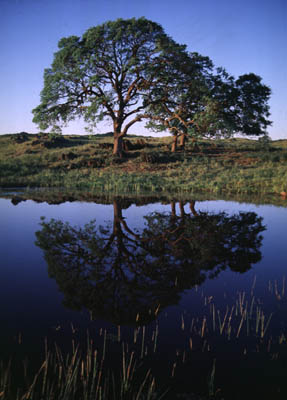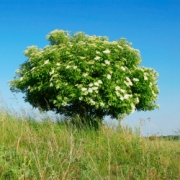The Oak
We think of the Oak as the nost English of trees and it was, not so long ago, of immense importance in the daily lives of our people.
When Britannia first ruled the waves it was the oak that furnished wood for her ships. Throughout the middle ages and into the modern era the oak fought the Englishman’s naval battles, carried his merchant cargoes, spanned his houses and churches, fed his swine, tanned his leather, made his furniture and provided medicine for him. Its dead wood fuelled the fires on his hearth. But today we have little memory of the debt we owe to the oak.
Oak Tree
The oak grew in the sacred groves of the Celts and the Anglo-Saxons and to us of the Odinic faith it is still recognised as an holy tree. Its folk-name comes from Anglo-Saxon ‘ac’ and its botanical name, quercus, is derived from the Celtic ‘guer’, fine, and ‘cuez’, tree. It is closely interwoven in the history of the English nation and our love and reverence for it goes far back into those times where history fades into myth. It is pre-eminently the tree sacred to Thor, not only in England but in all the lands of Northern Europe and there is no doubt that it was seen as holy by all the Germanic peoples. It was the special tree not only in England but in Europe as a whole.
Findings in archaeological digs of Bronze Age relics have revealed coffins and artefacts of oak in burial chambers. Maximus of Tyre, writing in the second century CE, describes the Celts as worshipping the oak as a symbol of Zeus. Pliny wrote of the sacredness of the oak and of oak groves in Gaul. In the eighth century CE the christian Boniface, an Anglo-Saxon who played a leading role in spreading his religion into pagan Germany, causing the felling of the sacred Oak of Thor at Geismar, in Hesse.
 To swear by Thor’s tree is to take an oath in Thor’s name, and the ancient solemn oath, ‘by oak, by ash and by thorn’, carried forward into christian times an Odinic oath disguised. So too, the pagan reverence for the oak was carried forward and like so many of our traditions was taken over by the usurping doctrines. This is shown in place-names such as Cress-age, in Shropshire, which was Christ’s Oak in the Domesday Book and no doubt Thor’s Oak in pre-christian times. There are ‘holy oaks’ on parish boundaries where at one time the gospel was read during another pagan tradition in christian dress; the ‘beating of the bounds’- at Rogationtide, a custom recently revived in several places.
To swear by Thor’s tree is to take an oath in Thor’s name, and the ancient solemn oath, ‘by oak, by ash and by thorn’, carried forward into christian times an Odinic oath disguised. So too, the pagan reverence for the oak was carried forward and like so many of our traditions was taken over by the usurping doctrines. This is shown in place-names such as Cress-age, in Shropshire, which was Christ’s Oak in the Domesday Book and no doubt Thor’s Oak in pre-christian times. There are ‘holy oaks’ on parish boundaries where at one time the gospel was read during another pagan tradition in christian dress; the ‘beating of the bounds’- at Rogationtide, a custom recently revived in several places.
Another custom of obvious pagan origin is the wearing of oak leaves or oak-apples on 29 May, Royal Oak Day, a tradition kept up until very recent times. This has been linked with the spring festival at the beginning of the month. At one time there must have been a cycle of festivals in this Merrymoon, with the Green Man of May Day, with his circlet of oak leaves be- ginning the cycle and an oak leaf festival ending it. Royal Oak Day has become associated with the legend of King Charles II being saved after the battle of Worcester by hiding in the branches of the Boscobel oak. But so many and varied local customs are attached to it that it must be a far older tradition.
The wood of the oak tree, especially the ‘heart of oak’, is immensely durable and, except by fire, almost indestructible. Oak logs have been dug from peat bogs after being buried for thousands of years, still in a usable condition. At one time England was covered by great oak forests and in Anglo-Saxon times they were protected by law. Herds of swine were fattened on the acorn mast and fines were im1xsed on anyone injuring an oak tree. Our ancestors resorted to the oak for its medicinalacorn virtues and used the bark, the roots, the fruit and the leaves. We, however, must conserve the few oak forests we have left and, for herbal remedies, use only the fruit and the leaves. Acorns can be ground and seeped in wine or water to make a powerful antiseptic. In an emergency the leaves can be crushed until pulpy and applied directly to wounds. A decoction of leaves (a pint of water to one half ounce dried – or a quarter ounce fresh – leaves, boiled together; give a tablespoon every three hours) can be used to quell a difficult fever. It is also a useful gargle for colds and sore throats.
The oak is an immensely long-lived tree. It can live for two millennia and grow to a girth exceeding sixty feet around. Oaks are not mature until they reach an age of nearly a hundred years.
There are few oak forests left. The slow development of their wood, which does not reach perfection until maturity, has made this fast-paced, greed-dominated era reject it as timber despite its superlative qualities. It is a tree of the past and a symbol of our past greatness.
Yet, as we walk beneath the boughs of this tree we can feel the power in it and we know that each acorn it produces can grow to become a mighty oak in its turn. We see the acorn as a symbol too – a small thing holding life and power within it.
The renewal of our old religion may seem of small consequence in the modern world yet it holds within it, like the seed of the oak, a latent power, a power that can generate our people.





Leave a Reply
Want to join the discussion?Feel free to contribute!